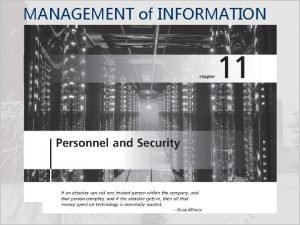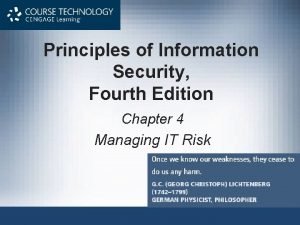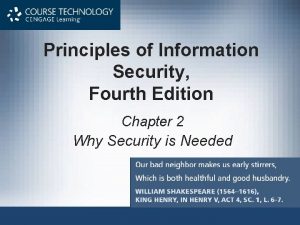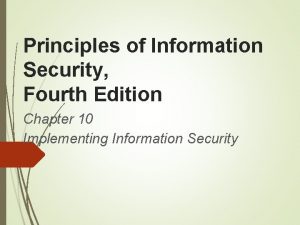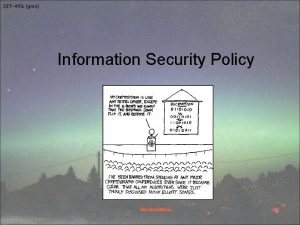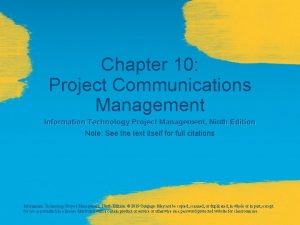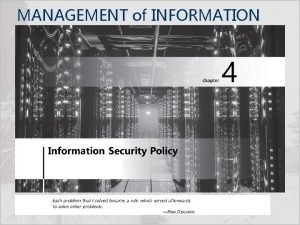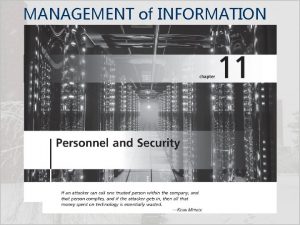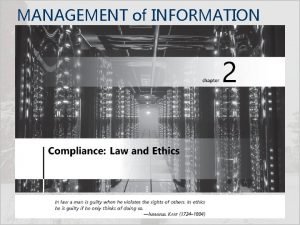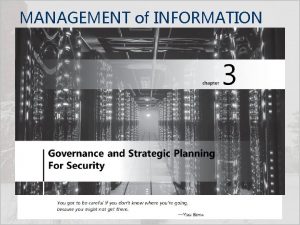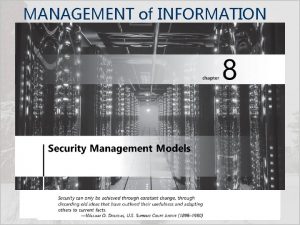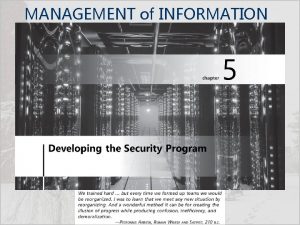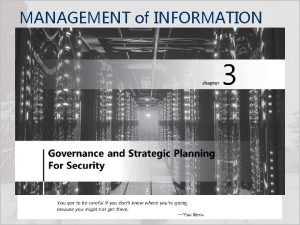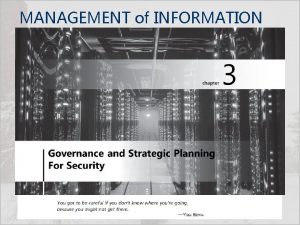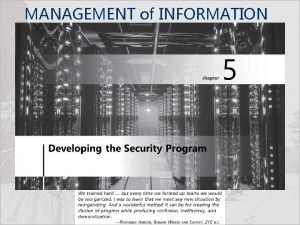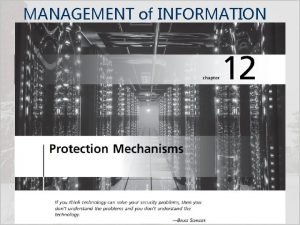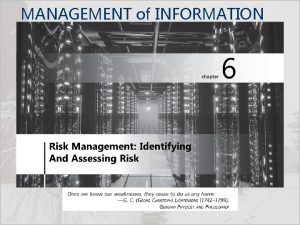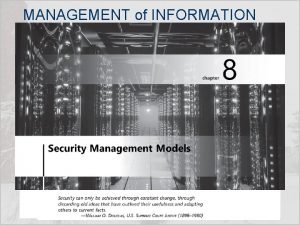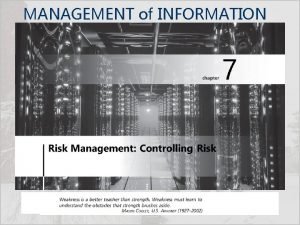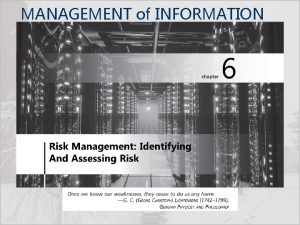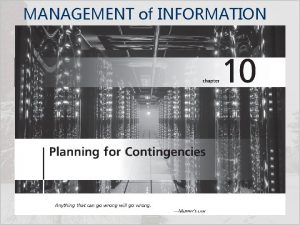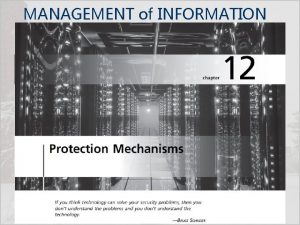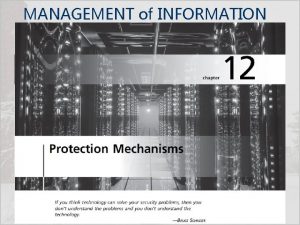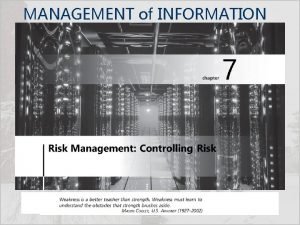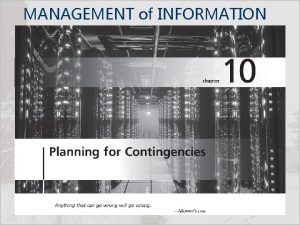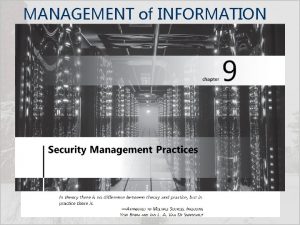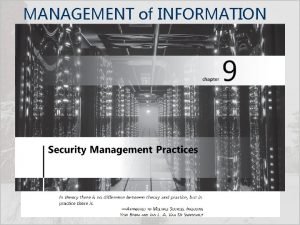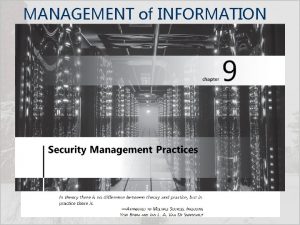MANAGEMENT of INFORMATION SECURITY Fifth Edition Security Policy



























- Slides: 27

MANAGEMENT of INFORMATION SECURITY, Fifth Edition

Security Policy - 2 Management of Information Security, 5 th Edition, © Cengage Learning 2

Guidelines for Effective Policy • For policies to be effective, they must be properly: 1. Developed using industry-accepted practices, and formally approved by management 2. Distributed using all appropriate methods 3. Read by all employees 4. Understood by all employees 5. Formally agreed to by act or affirmation 6. Uniformly applied and enforced Management of Information Security, 5 th Edition, © Cengage Learning 3

Developing Information Security Policy • It is often useful to view policy development as a threepart project – In the first part of the project, policy is designed and written (or, in the case of an outdated policy, redesigned and rewritten) – In the second part, a senior manager or executive at the appropriate level reviews and formally approves the document – In the third part of the development project, management processes are established to perpetuate the policy within the organization • The first part is an exercise in project management, while the latter two require adherence to good business practices Management of Information Security, 5 th Edition, © Cengage Learning 4

Policy Distribution • Can be accomplished by: – hard copy distribution – electronic distribution • Unless the organization can prove that the policy actually reached the end users, it cannot be enforced • Distribution of classified policies requires additional levels of controls, in the labeling of the document, in the dissemination of new policy, and in the collection and destruction of older versions to assure the confidentiality of the information contained within the policy documents themselves Management of Information Security, 5 th Edition, © Cengage Learning 5

Policy Reading • Barriers to employees’ reading policies can arise from literacy or language issues • Visually impaired employees require additional assistance, either through audio or large-type versions of the document • Multinational organizations also must deal with the challenges of gauging reading levels and language translations foreign citizens Management of Information Security, 5 th Edition, © Cengage Learning 6

Readability Statistics Management of Information Security, 5 th Edition, © Cengage Learning 7

Readability Statistics Management of Information Security, 5 th Edition, © Cengage Learning 8

Policy Comprehension • To be certain that employees understand the policy, the document must be written at a reasonable reading level, with minimal technical jargon and management terminology • The next step is to use some form of assessment to gauge how well employees understand the policy’s underlying issues • Quizzes and other forms of examination can be employed to assess quantitatively which employees understand the policy by earning a minimum score, and which employees require additional training and awareness efforts before the policy can be enforced Management of Information Security, 5 th Edition, © Cengage Learning 9

Policy Compliance • “Policies must be agreed to by act or affirmation. Agreement by act occurs when the employee performs an action, which requires them to acknowledge understanding of the policy, prior to use of a technology or organizational resource” • What if an employee refuses explicitly to agree to comply with policy? • It seems clear that failure to agree to a policy is tantamount to refusing to work and thus may be grounds for termination Management of Information Security, 5 th Edition, © Cengage Learning 10

Policy Enforcement • The final component of the design and implementation of effective policies is uniform and impartial enforcement • As in law enforcement, policy enforcement must be able to withstand external scrutiny • If an employee is punished, censured, or dismissed as a result of a refusal to follow policy and is subsequently able to demonstrate that the policies are not uniformly applied or enforced, the organization may find itself facing punitive as well as compensatory damages Management of Information Security, 5 th Edition, © Cengage Learning 11

Automated Tools • The need for effective policy management has led to the emergence of a class of software tools that supports policy development, implementation, and maintenance • Tools like Vigilent Policy Center (VPC) keep policies confidential, behind passwordprotected intranets, and generate periodic reports indicating which employees have and have not read and acknowledged the policies Management of Information Security, 5 th Edition, © Cengage Learning 12

Policy Development and Implementation Using the Sec. SDLC • Like any major project, a policy development or redevelopment project should be well planned, properly funded, and aggressively managed to ensure that it is completed on time and within budget • One way to accomplish this goal is to use a systems development life cycle (SDLC) Management of Information Security, 5 th Edition, © Cengage Learning 13

Investigation Phase • The policy development team should attain: – Support from senior management, – Support and active involvement of IT management, specifically the CIO – Clear articulation of goals – Participation of the correct individuals from the communities of interest affected by the policies • Be composed from Legal, Human Resources and end-users • Assign a project champion with sufficient stature and prestige • Acquire a capable project manager – A detailed outline of the scope of the policy development project and sound estimates for the cost and scheduling of the project Management of Information Security, 4 th Edition, © Cengage Learning 14

Analysis Phase • The Analysis phase should include the following activities: – A new or recent risk assessment or IT audit documenting the current Info. Sec needs of the organization – The gathering of key reference materials— including any existing policies Management of Information Security, 4 th Edition, © Cengage Learning 15

Design Phase • The first task in the design phase is the drafting of the actual policy document • While this task can be done by a committee, it is most commonly done by a single author – There a number of references and resources available on the Web, through professional literature and from peers and consultants • Next, the development team or committee reviews the work of the primary author and makes recommendations about its revision • Once the committee approves the document, it goes to the approving manager or executive for sign-off Management of Information Security, 4 th Edition, © Cengage Learning 16

Implementation Phase • In the implementation phase, the team must create a plan to distribute and verify the distribution of the policies • Members of the organization must explicitly acknowledge that they have received and read the policy (compliance) • The simplest way to document acknowledgment of a written policy is to attach a cover sheet that states “I have received, read, understood, and agreed to this policy” – The employee’s signature and date provide a paper trail of his or her receipt of the policy Management of Information Security, 4 th Edition, © Cengage Learning 17

End User License Agreement Management of Information Security, 4 th Edition, © Cengage Learning 18

Maintenance Phase • During the maintenance phase, the policy development team monitors, maintains, and modifies the policy as needed to ensure that it remains effective as a tool to meet changing threats • The policy should have a built-in mechanism via which users can report problems with the policy, preferably anonymously • Periodic review should be built in to the process Management of Information Security, 4 th Edition, © Cengage Learning 19

Automated Tools • The need for effective policy management has led to the emergence of a class of software tools that supports policy development, implementation, and maintenance • Tools like Vigilent Policy Center (VPC) keep policies confidential, behind password-protected intranets, and generate periodic reports indicating which employees have and have not read and acknowledged the policies • Tools such as VPC also make it clear which manager was responsible for the policy, as his or her name is prominently displayed on the policy, along with the date of approval Management of Information Security, 5 th Edition, © Cengage Learning 20

Vigil. Ent Policy Center Management of Information Security, 5 th Edition, © Cengage Learning 21

Other Approaches to Information Security Policy Development • There a number of other approaches to developing information security policy – Information Security Policies Made Easy Approach – SP 800 -18, Rev. 1: Guide for Developing Security Plans for Federal Information Systems Management of Information Security, 5 th Edition, © Cengage Learning 22

Policy Administrator • Just as information systems and Info. Sec projects must have a champion and a manager, so must policies • The policy champion position combined with the manager position is called the policy administrator • Typically, this person is a mid-level staff member who is responsible for the creation, revision, distribution, and storage of the policy Management of Information Security, 5 th Edition, © Cengage Learning 23

Review Schedule • In a changing environment, policies can retain their effectiveness only if they are periodically reviewed for currency and accuracy, and modified to keep them updated • Any policy document should contain a properly organized schedule of reviews • Generally, a policy should be reviewed at least annually Management of Information Security, 5 th Edition, © Cengage Learning 24

Review Procedures and Practices • To facilitate policy reviews, the policy administrator should implement a mechanism by which individuals can easily make recommendations for revisions to the policies and other related documentation • Recommendation methods could include e-mail, office mail, or an anonymous drop box • Once the policy has come up for review, all comments should be examined and management -approved changes should be implemented Management of Information Security, 5 th Edition, © Cengage Learning 25

Policy and Revision Date • In some organizations, policies are drafted and published without a date, leaving users of the policy unaware of its age or status • This practice can create problems, including legal ones, if employees are complying with an out-of-date policy • Ideally, the policy document should include its date of origin, along with the dates, if any, of revisions • Some policies may need a “sunset clause, ” particularly if they govern information use for a short-term association with second-party businesses or agencies Management of Information Security, 5 th Edition, © Cengage Learning 26

A Final Note on Policy • As mentioned earlier, while policies can help organizations avoid litigation, their first and foremost function is to inform employees of what is and is not acceptable behavior in the organization • Policy development is meant to improve employee productivity and prevent potentially embarrassing situations • In reality, most employees inherently want to do what is right. If properly educated on what is acceptable and what is not, they will choose to follow the rules for acceptable behavior Management of Information Security, 5 th Edition, © Cengage Learning 27
 Management of information security 5th edition
Management of information security 5th edition Principles of marketing fifth european edition
Principles of marketing fifth european edition Appraisals in lazarus's theory of emotion
Appraisals in lazarus's theory of emotion Fundamentals of corporate finance fifth edition
Fundamentals of corporate finance fifth edition Fifth edition chemistry a molecular approach
Fifth edition chemistry a molecular approach Molecular biology of the cell
Molecular biology of the cell Molecular biology
Molecular biology Human anatomy fifth edition
Human anatomy fifth edition Human anatomy fifth edition
Human anatomy fifth edition Failure of supporting utilities and structural collapse
Failure of supporting utilities and structural collapse Principles of information systems, seventh edition
Principles of information systems, seventh edition Concentration risk
Concentration risk 12 principles of information security
12 principles of information security Principles of information security 4th edition
Principles of information security 4th edition Integrity in e commerce
Integrity in e commerce Ispme
Ispme Information technology project management 9th edition
Information technology project management 9th edition Blue project chapter 5
Blue project chapter 5 Vertical
Vertical Information technology project management 8th edition
Information technology project management 8th edition Project management chapter 6
Project management chapter 6 Introduction to management information systems 5th edition
Introduction to management information systems 5th edition The time/space collaboration and social tool matrix
The time/space collaboration and social tool matrix Information technology project management 9th edition
Information technology project management 9th edition Using mis (10th edition) 10th edition
Using mis (10th edition) 10th edition Zulily case study
Zulily case study Private secruity
Private secruity Visa international security model diagram
Visa international security model diagram
